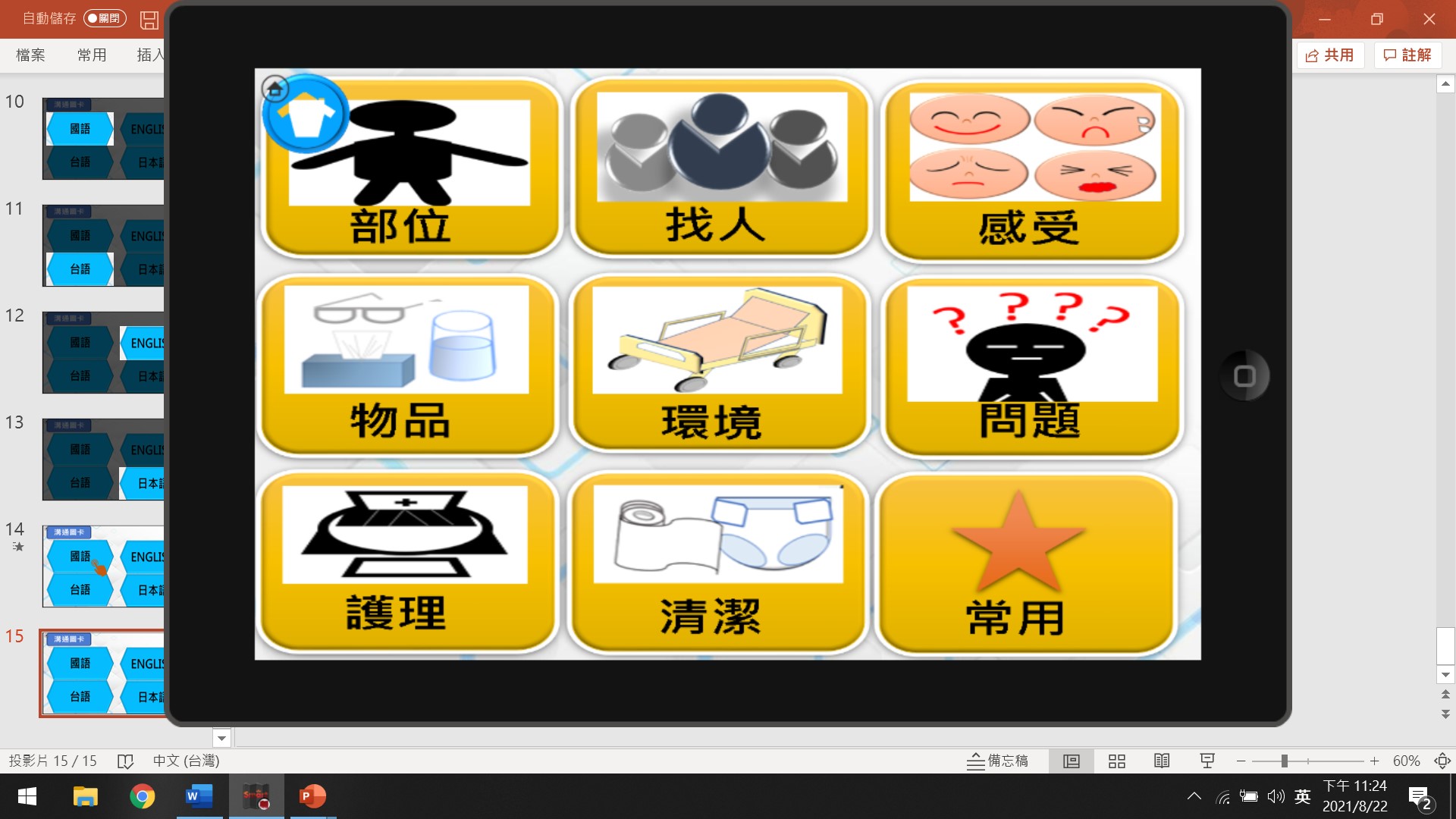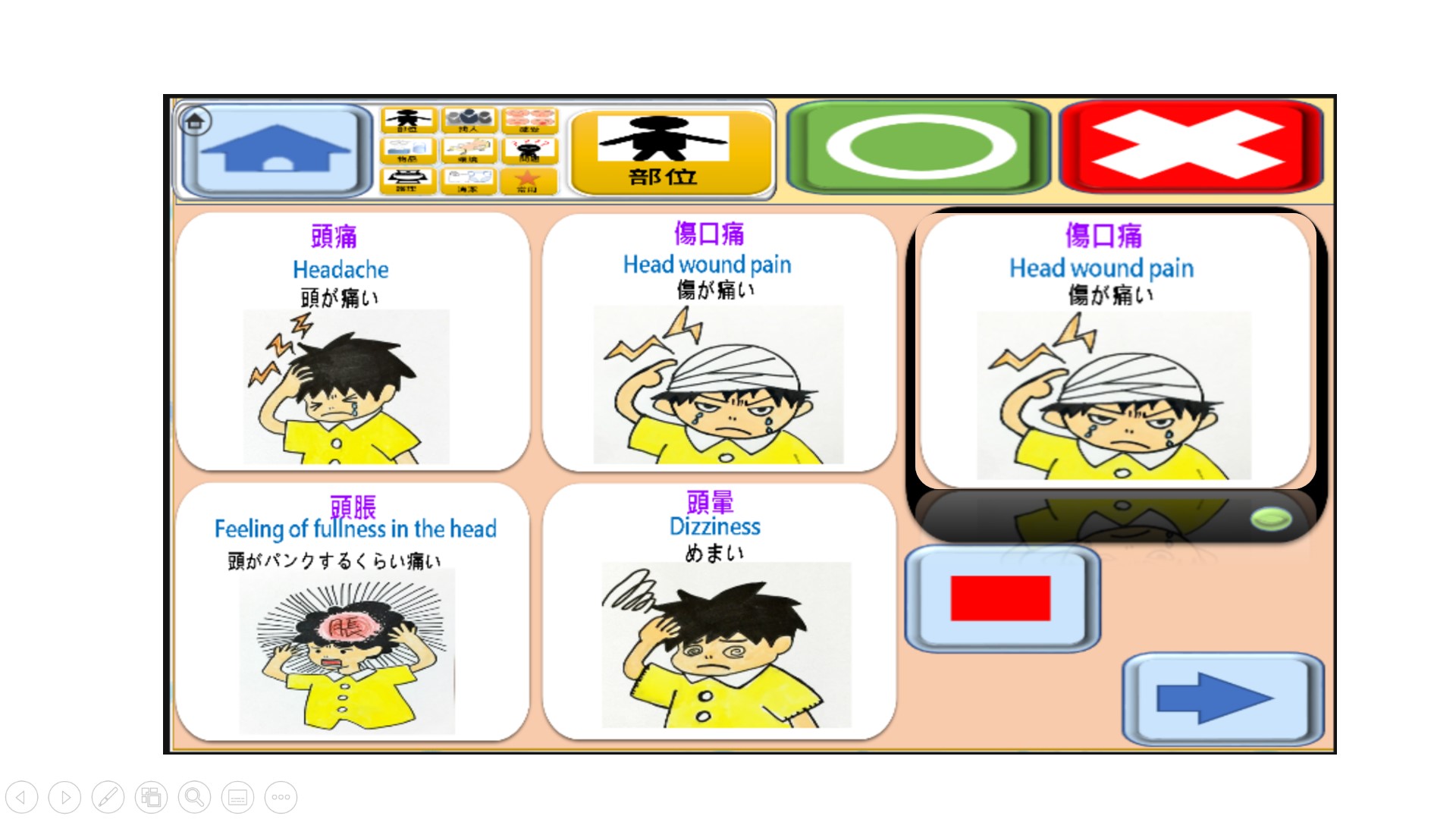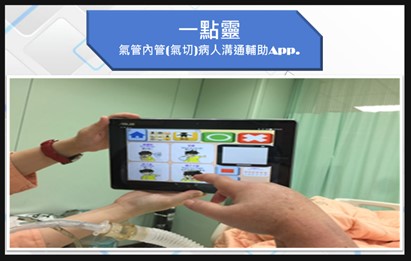Introduction
"Communication" is the act of passing messages and expressing needs and feelings between people. It can be communicated through oral language, body movements, facial expressions, words, symbols, and patterns. People's usual method is oral communication. However, some patients in the intensive care unit cannot speak due to the placement of endotracheal tubes or tracheotomy tubes. They communicate their needs by mouth or body movements. Still, They are limited by the patient's ability to express or the understanding of medical staff so that they can express their needs. It cannot be understood. Medical staff may make wrong judgments and dispositions by inquiring or guessing. Commonly used communication aids in clinical practice have limitations and shortcomings. For example, communication charts will have vocabulary limitations, the alphabet board cannot be used immediately in an emergency, and the writing board will be affected by the patient's illiteracy, physical weakness, or disease factors. Unable to hold the pen to write. When the patient's expression cannot be understood, it is easy to have negative emotions, such as anxiety, depression, anger, etc., which may cause the patient to pull out of the circuit and endanger their safety.
This communication assistance APP is designed for patients with endotracheal or tracheotomy tubes in intensive care units. Its content is compiled based on clinical observations, patient interviews, nursing staff questionnaires, and literature verification to collect data. The communication assistance APP is designed in line with Chinese culture. The main screen is divided into three parts: the communication card interface. Divide the needs into nine categories: parts, environment, finding people, feelings, items, nursing, cleaning, problems, common use, presentation in pictures and text, and voice output in four languages (Mandarin, Taiwanese, English, Japanese). The pain assessment interface has pain site maps and a pain assessment scale. With Wordpad and phonetic symbols interface, you can handwrite text or input alphabet symbols on the screen. This product is designed as a communication aid APP to help patients express their needs smoothly, express opinions or make decisions about treatment and care, reduce the negative impact of poor communication, and improve the quality of physical and mental care.
Features / strengths
Exclusive design, patient-centered voice for critically ill patients
Nurses invented this communication assistant APP in the intensive care unit. It was found that patients with endotracheal tube/tracheotomy tube indwelling clinically have limitations and deficiencies in the use of communication methods and assistive devices. Therefore, the communication assistant APP was designed. The content was compiled based on Clinical observations, patient interviews, nursing staff questionnaires, and literature verification used to collect data, design a communication assistance APP that conforms to Chinese culture and accurately meets the needs of patients, helping critically ill patients to express their needs or feelings smoothly so that patients can receive appropriate physical and mental care.
System classification, graphic display, intuitive options, easy operation
The content of this communication assistance APP is compiled based on clinical observations, patient interviews, nursing staff questionnaires, and literature verification to collect data. The communication assistance APP is designed in line with Chinese culture because it is specially designed for patients with endotracheal tubes or tracheotomy tubes in intensive care units. And considering that the users are critically ill patients and most of them are elderly, the interface design is designed with large patterns and fonts, and the patterns are clear. In operation, the click method allows patients to select intuitively and conveniently. It is divided into three main interfaces as follows:
1. Communication card interface:
(1) Four commonly used languages, voice output: graphic presentation, four languages (Mandarin, Taiwanese, English, Japanese) voice output
(2) The communication charts are classified and easy to click:
Summarize and sort out the communication needs of patients and divide them into nine categories: site, environment, finding people, feelings, items, nursing, cleaning, problems, and common use.
The human figure selects the parts. If you click on the head, the facial features will appear, and you can click on it, so you can clearly understand the part the patient wants to express.
After clicking on the "Needs/Feelings" chart, the related "Care/Disposal" options will appear, allowing patients to express their "needs/feelings" and also know the care/disposition they expect"; for example: click Headache, the screen will appear: take medicine, injection, physician, pain assessment options.
2. Pain assessment interface:
(1) Pain score: There are 0-10 points for pain score and pain mask, allowing the patient to choose the current pain intensity. When the patient chooses the score, the later score will be displayed directly above, making the pain score clear. Example: Clicking on the pain score is 6, so the score will be displayed right above.
(2) The nature of pain: Nine types of pain are common in clinical practice. After selection, other options will disappear, making the nature of pain clear. Example: Click on Tenderness so that other options will disappear.
3. Wordpad and phonetic symbols interface:
(1) Phonetic symbol interface: input software for phonetic symbols and English letters, click the phonetic symbols to form text and click to express the text to form a sentence.
(2) Writing pad: handwriting software, you can use your fingers to write the words you want to write on the writing pad so that you can not hold the author (hand injury, hemiplegia, limb weakness...) to write text; click to express words, forming sentences.
This "Communication Assistance App." is an App. Patients or their family members can download and use their mobile devices, which is hygienic and reduces the chance of cross-infection. It is convenient for foreigners, and the color demand map allows illiterate patients to choose. As long as there is a network, personal mobile devices can also be used for convenience. It can be used by all people who need it: patients with endotracheal tube indwelling (inability to talk in writing, illiterate), people with ALS, head and neck cancer, head and neck surgery, foreign cultures, and people with language and communication impairments can download and use it. It can be extended to other intensive care wards, general wards, home care or long-term care ditch, etc., for patients with indwelling endotracheal tubes (tracheotomy tubes) or other patients with communication difficulties.
This invention won the Silver Medal Award in the Invention Competition of the Taiwan Innotech Expo in 2021 and the Excellence Award in the Nursing Innovation Competition of the National Federation of Nursing and Nursing Associations of the Republic of China in 2018 and obtained the Republic of China Patent. This product is a legal person of the Mackay Medical Foundation of the Presbyterian Church in Taiwan. Mackay Memorial Hospital and the National Taipei University of Nursing and Health are the works of industry-university cooperation. They have conducted academic research and published papers on the effectiveness of their use. Hopefully, this product can be promoted to medical institutions, home care, nursing homes, and long-term care institutions.
Specification in detail






